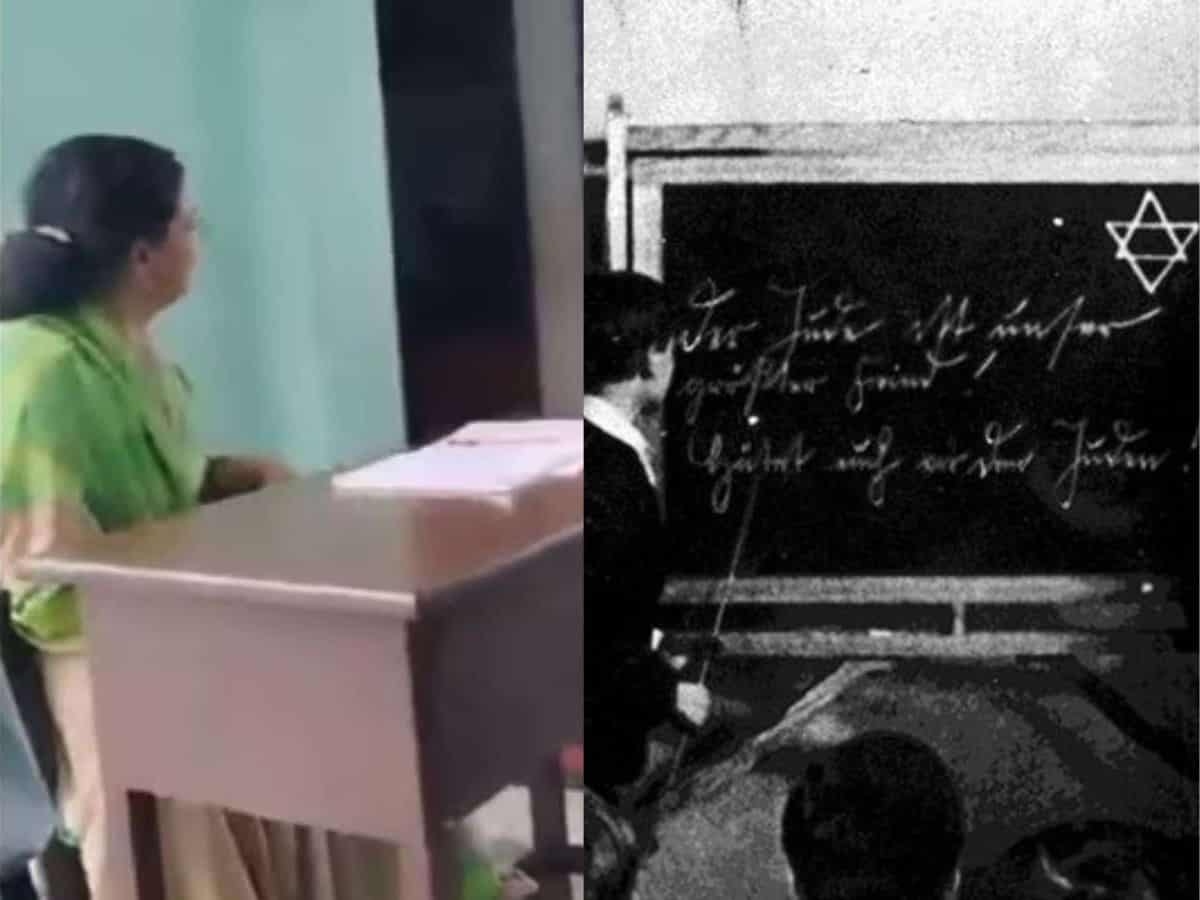
Hyderabad: AIMIM chief and MP Asaduddin Owaisi on Saturday described the current situation of Indian Muslims as similar to Jews in Germany in the 1930s, saying Indian Muslims face the same ‘discrimination’ and ‘persecution’.
Sharing a photo from Nazi Germany posted by a user on X, Owaisi said, “Indian Muslims are facing the same persecution & discrimination as Jews faced in the 1930s, will it lead to Kristallnacht? Hope not,” he wrote on X (formerly Twitter) on a picture of two Jewish boys being humiliated in a German classroom in the 1930s.”
The photo show two Jewish boys were being humiliated in a German classroom where the blackboard reads: “The Jew is our biggest enemy. Beware of the Jew.”
Owaisi’s remarks came after the incident of a teacher asking students to slap a Muslim classmate in UP’s Muzaffarpur came to light. The video of the incident was widely circulated on social media and sparked a massive outrage.
In a video statement posted on X, Owaisi said, “The incident is the result of BJP’s politics of hate in the country over the last nine years. The poor communities of the country especially Muslims and Dalits are being targeted. Besides BJP, all secular parties who turn a blind eye to such incidents for not upsetting the Hindu vote bank are also responsible for spreading the hate.”
He added, “If this hate does not stop, it will weaken the country. If we could reach the moon, why can we overcome hate?”
He also highlighted the dire straits of Muslims in UP in the field of education, “There are only 16.8% Muslims in UP with middle-level education, while the general population average is 25.5%. 74% Muslims in UP have no formal education, and only 4.4% have a university degree.”
The accused teacher, Tripta Tyagi, has been booked for a non-cognizable offence under sections 504 (punishment for insulting someone), and 323 (punishment for voluntarily causing hurt) of the Indian Penal Code.
“I spoke with the victim’s father in the morning. My heart was shattered when he told me that he did not file a complaint because it could disturb peace in their village,” Owaisi said.
Today, a father can’t protect his child’s dignity and right to education in this country, he said. “The child will bear the psychological impact of the shameful incident all his life. I have requested the father of the child to send him to Hyderabad. We will take care of his education.”
The case was registered based on the complaint of the student’s father, who had earlier refused to file a complaint after coming to an ‘understanding’ with the school. Later, he decided to cancel his son’s admission and the school reimbursed the fee.
What is Kristallnacht?
According to Wikipedia, Kristallnacht or the Night of Broken Glass, also called the November pogrom(s) was a pogrom against Jews carried out by the Nazi Party’s Sturmabteilung (SA) paramilitary and Schutzstaffel (SS) paramilitary forces along with some participation from the Hitler Youth and German civilians throughout Nazi Germany on 9-10 November 1938. The German authorities looked on without intervening.
The name Kristallnacht (literally ‘Crystal Night’) comes from the shards of broken glass that littered the streets after the windows of Jewish-owned stores, buildings, and synagogues were smashed. The pretext for the attacks was the assassination of the German diplomat Ernst vom Rath by Herschel Grynszpan, a 17-year-old German-born Polish Jew living in Paris.
Jewish homes, hospitals, and schools were ransacked as attackers demolished buildings with sledgehammers. Rioters destroyed 267 synagogues throughout Germany, Austria, and the Sudentland. Over 7,000 Jewish businesses were damaged or destroyed, and 30,000 Jewish men were arrested and incarcerated in concentration camps.
British historian Martin Gilbert wrote that no event in the history of German Jews between 1933 and 1945 was so widely reported as it was happening, and the accounts from foreign journalists working in Germany drew worldwide attention.
The Times of London observed on 11 November 1938: “No foreign propagandist bent upon blackening Germany before the world could outdo the tale of burnings and beatings, of blackguardly assaults on defenceless and innocent people, which disgraced that country yesterday.”
Estimates of fatalities caused by the attacks have varied. Early reports estimated that 91 Jews had been murdered. Modern analysis of German scholarly sources puts the figure much higher; when deaths from post-arrest maltreatment and subsequent suicides are included, the death toll reaches the hundreds, with some estimating 638 deaths by suicide. Historians view Kristallnacht as a prelude to the Final Solution and the murder of six million Jews during the Holocaust.



